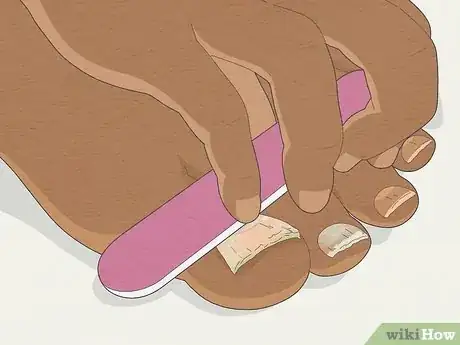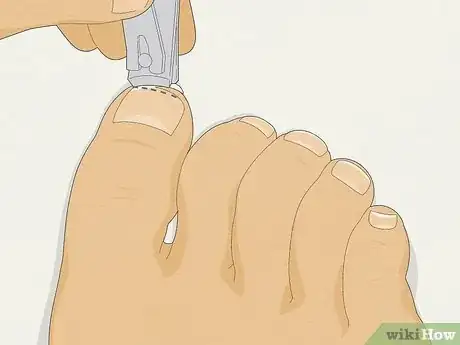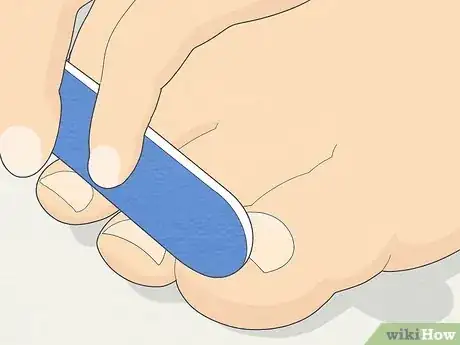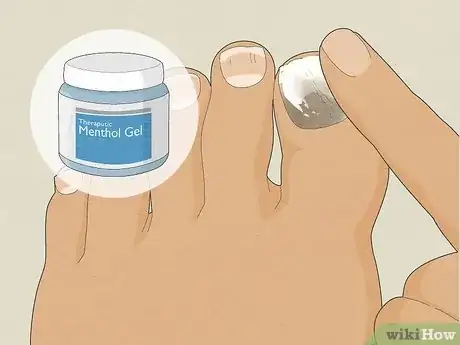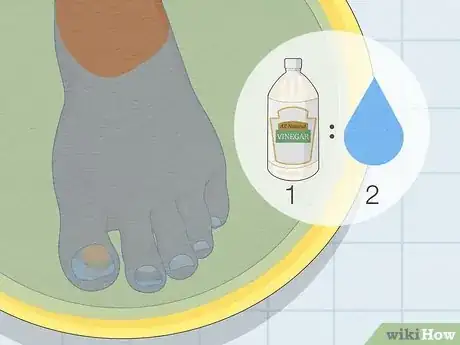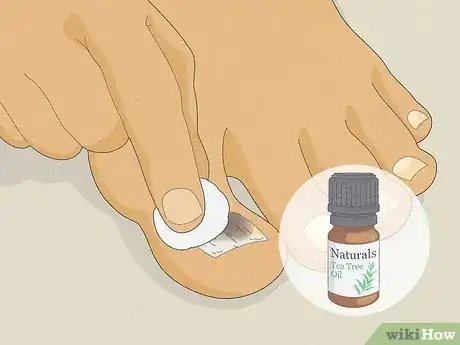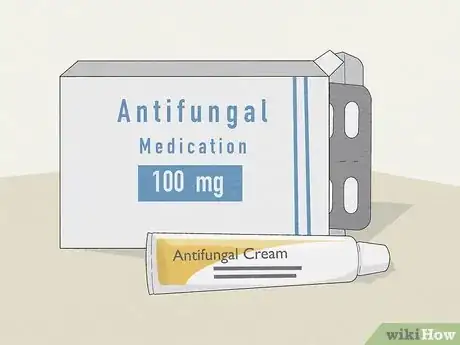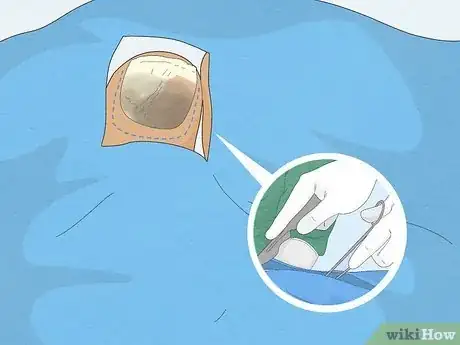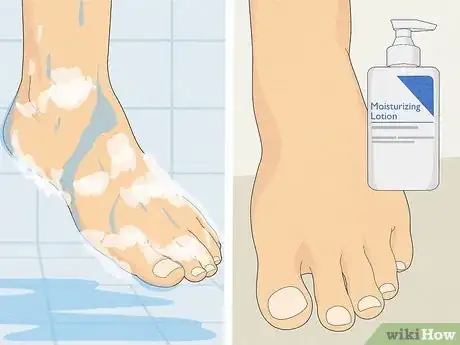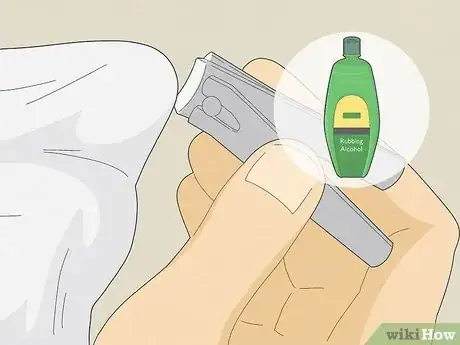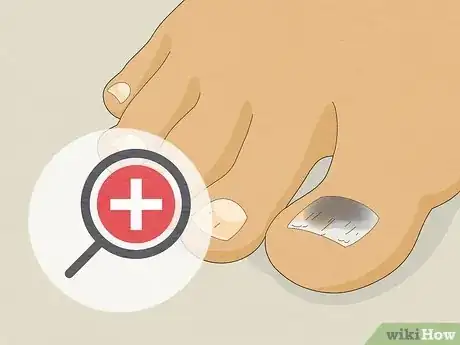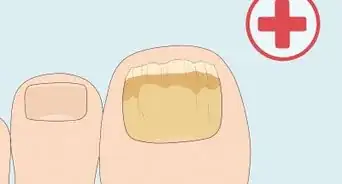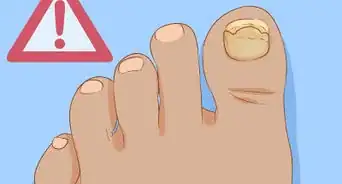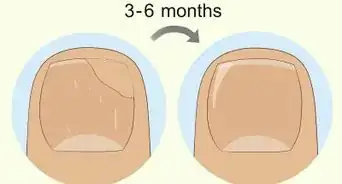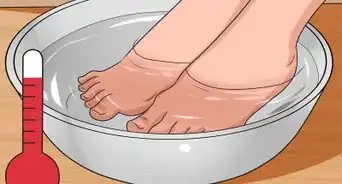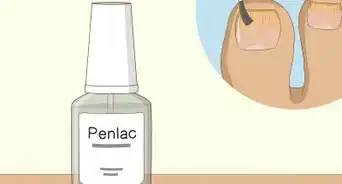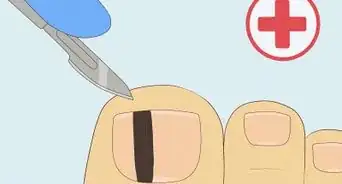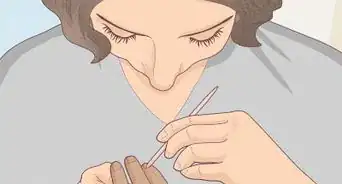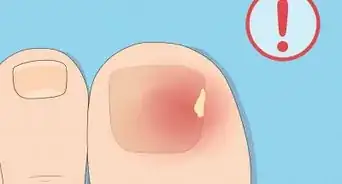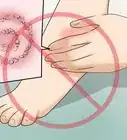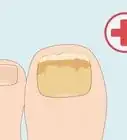This article was medically reviewed by Mark Co, DPM and by wikiHow staff writer, Hunter Rising. Dr. Mark Co is a Podiatrist who runs his own private practice in San Francisco, California. Dr. Co specializes in treatments for bunions, ingrown toenails, toenail fungus, warts, plantar fasciitis and other causes of foot pain. He also offers custom orthotics for the treatment and prevention of foot and ankle issues. Dr. Co completed a Master of Business Administration (MBA) at New York University and an MA in Electrical Engineering and Computer Science at Johns Hopkins University. Dr. Co also completed his DPM at the California School of Podiatric Medicine and a residency and internship at the Kaiser Permanente Medical Center, Santa Clara, California. Dr. Co was awarded San Francisco's "Top 3 Podiatrists" in 2018, 2019, and 2020. Dr. Co is also a member of the CPMA (American Podiatric Medical Association).
There are 18 references cited in this article, which can be found at the bottom of the page.
wikiHow marks an article as reader-approved once it receives enough positive feedback. This article received 17 testimonials and 100% of readers who voted found it helpful, earning it our reader-approved status.
This article has been viewed 3,256,503 times.
If you’ve noticed your toenails are discolored or thicker than normal, there’s a chance you’re dealing with toenail fungus. While mild cases of nail fungus aren’t a serious issue, it could spread or make your nails worse if you leave it untreated. The good news is that there are tons of treatment options you can try to restore the look of your nails. Keep reading for a complete guide on cutting and treating nails at home, consulting with your doctor, and preventing future infections.
Things You Should Know
- Scrape off white fungus marks on your nails with a nail file. Trim down infected parts of your nails with nail nippers.
- Use an over-the-counter antifungal on your toenails daily to kill the fungus. Menthol cream, tea tree oil, or snakeroot extract may work too.
- Take prescription oral or topical medications from your doctor for the most effective treatment.
- You'll know your toe nail fungus is dying when your infected nail becomes less thick and any discoloration begins to fade.[1]
Steps
Cutting and Filing Toenail Fungus
-
1Apply urea cream to your nails the night before you trim them. Urea cream soaks into your nails to make them softer, and it makes fungus easier to scrape off. Rub the cream into the infected toenails and put a bandage over them.[2]
-
2Soak your nails in warm water for 10 minutes to soften them. Fill a small bowl or tub with warm water from the tap and submerge your toes. Since your toenails with fungus are thicker, soaking them will help make them soft and easier to cut. After 10 minutes, pat your nails dry with a towel.[3]
- Alternatively, you can take a shower to soften your nails and trim them as soon as you’re finished.
- If your nails still feel hardened or tough after 10 minutes, try soaking them for up to 30 minutes.
Advertisement -
3Scrape off any white fungal marks on your toenails with a file. The white marks on your toenails are signs of fungus, and scraping them off can help thin your nail. Move the file with small movements in the same direction to shave off as much of the infected nail as you can.[4]
- Filing the surface of your nail will remove some of the infection, but it won’t completely kill the fungus. However, thinning your nails can help make other topical antifungal treatments more effective.
- If you have extremely thick toenails, you can try sanding down nail fungus with an electric file. Gently press the file against your nail to shave it down. Just stop using it if you feel any pain.[5]
-
4Cut straight across your nails with a pair of nail nippers. Nail nippers look like a small pair of pliers and they make it a little easier to cut through thicker nails than standard clippers. Trim your nails starting from the outer corners and making small, straight horizontal cuts. Just cut through the white part of your nail so you don’t accidentally dig into your nail bed.[6]
- Avoid rounding off the corners of your nails prevent ingrown toenails.
-
5Smooth the edges of your nail with your file. Gently run your file along the sharp edges of your nail so it doesn’t snag or get caught on anything. This helps ensure your nails don’t get more damaged and susceptible to fungus.[7]
- File in the same direction instead of moving it back and forth so you’re less likely to weaken your nail.
Treating Nail Fungus at Home
-
1Apply an over-the-counter antifungal medication to your nails. Antifungal nail treatment usually comes in a solution similar to nail polish or in an ointment.[8] Spread the antifungal medicine over the infected nails and between your toes after you wash and trim them. Use the medication twice a day for up to 2 weeks.[9]
- Antifungal medications kill fungus on the nail surface and the nail bed, but they don’t usually penetrate through thick nails.
-
2Rub menthol cream onto your nails. Scoop out a fingertip-sized amount of the menthol cream and apply a small amount to the affected nail twice a day. Try to do this right after a shower so that your toes are already nice and clean. Use the menthol cream every day for 1–2 months to completely clear up the fungus.[10]
- Menthol cream works as an antiseptic that kills germs that cause the fungus to spread.
-
3Soak your toenails in vinegar twice a day as a natural disinfectant. Fill a bowl with 1 part white vinegar and 2 parts warm water and dip your toenails in the solution. Let your nails sit in the vinegar for about 15 minutes before rinsing them off with clean water. Keep using vinegar for a month or two until you see the fungus disappear.[11]
- Add more water to the solution and use it every other day if your skin gets irritated from the solution.
-
4Coat your nail with tea tree oil to use a natural antifungal. Mix 1 teaspoon (4.9 ml) of tea tree oil with 1⁄2 teaspoon (2.5 ml) of olive oil. Use a cotton ball to rub the oil solution directly onto your nail. Repeat the process every morning and night until you notice the fungus improving.[12]
- Tea tree oil has astringent properties and antibacterial properties which can help clear up fungus.
-
5Try using snakeroot extract to kill the fungus. Wet a cotton ball or swab with the extract and apply it to your nail every 3 days for the first month you use it. During the second month, use it twice a week. During the third month, reduce your usage to once a week as the fungus clears up.[13]
- Snakeroot is related to sunflowers and it has natural antifungal properties that have similar effectiveness to over-the-counter medications.
-
6Apply garlic to the fungus to slow down its growth. Simply chop up a fresh clove of garlic and apply it directly to your affected nails. Put on clean socks and keep the garlic on your nails for 30 minutes. Then, just wash your nails off with soap and water. Use garlic once a day until you see the fungus starting to improve.[14]
- Alternatively, you can sprinkle garlic powder on your nail.
- Garlic has some natural antimicrobial properties that can kill and prevent fungus from spreading between your nails.
Seeking Medical Attention
-
1Contact your doctor if your toenails cause pain or have persistent fungus. Nail fungus usually isn’t a cause for concern, but it’s a problem if you notice it affecting your daily life. Set up an appointment and let your doctor know what you’re dealing with so they can figure out the best plan of action for you.[15]
- Your doctor may advise you to see a podiatrist or dermatologist for severe cases of toenail fungus.
- Even if nail fungus isn’t causing pain, you can still talk to your doctor if you’re concerned about the appearance of your nails.
- See a doctor right away if you have diabetes and develop nail fungus. Foot injuries or infections could lead to diabetic complications if you leave fungus untreated.
- Your doctor might take some nail clippings or scrape nail bed tissue to figure out the best solution or rule out conditions like psoriasis or infection.[16]
-
2Discuss prescription medications with your doctor. Your doctor will likely prescribe you an antifungal medication that’s more powerful than OTC options. Usually, you’ll either take medication orally or apply it topically directly to your nail.[17] Follow your doctor’s dosage or application instructions precisely to ensure the fungus clears up.[18]
- Terbinafine and itraconazole are the most common and effective oral medications. Typically, you’ll take a daily pill for 12 weeks to clear up toenail fungus.[19]
- Ciclopirox (Penlac) is a topical nail polish that’s less effective than oral medication, but it may work for a mild to moderate infection. You’ll typically paint layers of the polish onto your nail for 7 days. After that, you’ll file off the polish and apply new layers for as long as your doctor recommends.
-
3Get the nail surgically removed if your doctor recommends it. If the fungus is causing a lot of pain or if it’s really severe, your doctor may recommend a full or partial nail removal. Your doctor will numb your toe and surgically remove your toenail so they can treat the nail bed for fungus.[20]
- Your nail may or may not grow back. If you’re concerned about the appearance of your nail, ask if there are any other alternatives you could try.
Preventing Toenail Fungus
-
1Wash and moisturize your feet daily. Make sure to wash your feet with soap and warm water at least once a day. If you’re pretty active and sweat a lot, wash your feet whenever they get damp to get rid of bacteria. When you’re finished, dry your feet thoroughly and apply a moisturizer to keep them smooth and soft.[21]
- Wash your feet more frequently if you sweat a lot or if your feet are damp for other reasons, such as walking in the rain.
- Cleaning your feet helps get rid of germs and fungal microbes that could affect your nail.
-
2Put on dry shoes and socks every day. Since fungus thrives in damp environments, wear shoes and socks that are clean and dry. Choose moisture-wicking socks that draw the moisture away from your toes and nails. Try to choose shoes made from breathable materials, such as nylon.[22]
- Alternate which shoes you wear every day so they have time to dry out between uses.
- You can also sprinkle antifungal powder into your shoes when you aren’t wearing them to stop fungus from growing inside of them.
-
3Disinfect nail clippers with rubbing alcohol when you use them. Before and after you use the clippers, wipe them down with a cotton ball soaked with rubbing alcohol to kill any bacteria left on the surface.[23]
- Avoid sharing clippers with anyone else.
- Use a separate pair of small clippers for your fingernails. That way, you’re less likely to spread the fungus.
-
4Wear flip flops in public showers and locker rooms. The damp environments in locker rooms, pools, or public showers are breeding grounds for fungus. Invest in some plastic or rubber sandals to keep your feet safe and off the floor. Keep your flip flops on until you leave the area or put on socks and shoes.[24]
- Wash your flip flops with soap and water once a week so that they don't carry any fungus organisms.
-
5Get treatment for underlying health conditions. Conditions like diabetes and poor circulation can increase your risk of nail fungus. Talk to your doctor about ways you can get control over your diabetes or improve your circulation so you’re less likely to develop nail fungus in the future.[25]
- It is more difficult to get rid of fungus if you don't have other medical issues under control. Closely follow your doctor's instructions about diet and taking medications for other conditions if necessary.
Warnings
- Wait until the fungus clears up to apply nail polish since it could trap moisture and encourage more growth.[26]⧼thumbs_response⧽
Things You’ll Need
Cutting and Filing Toenail Fungus
- Nail file
- Urea cream (optional)
- Nail nippers
- Electric file (optional)
Using Home Remedies
- Antifungal solution
- Menthol cream
- Vinegar
- Tea tree oil
- Snakeroot extract
- Garlic
Preventing Toenail Fungus
References
- ↑ https://www.afacc.net/news/how-to-tell-if-toenail-fungus-is-dying/
- ↑ https://www.ncbi.nlm.nih.gov/books/NBK279546/
- ↑ https://www.mayoclinic.org/healthy-lifestyle/adult-health/multimedia/nails/sls-20076741?s=2
- ↑ https://www.ncbi.nlm.nih.gov/books/NBK279546/
- ↑ https://www.maphn.org/Resources/Documents/Foot%20and%20Nail%20Care%20Chapter%20Bryant%20TEXT%202010.pdf
- ↑ https://www.mayoclinic.org/healthy-lifestyle/adult-health/multimedia/nails/sls-20076741?s=2
- ↑ https://www.aad.org/public/everyday-care/nail-care-secrets/basics/how-to-trim-nails
- ↑ Mark Co, DPM. Podiatrist. Expert Interview. 21 April 2020.
- ↑ https://www.nhs.uk/medicines/terbinafine/
- ↑ https://www.jabfm.org/content/24/1/69
- ↑ https://www.rutlandskin.com/OTC%20Nail%20Remedies.pdf
- ↑ https://www.dermacentermd.com/docs/Natural%20Remedies%20for%20Toe%20Nail%20Fungus%20PDF.pdf
- ↑ https://www.aafp.org/dam/brand/aafp/pubs/afp/issues/2013/1201/p762.pdf
- ↑ https://www.thepharmajournal.com/archives/2012/vol1issue4/PartA/9.pdf
- ↑ Mark Co, DPM. Podiatrist. Expert Interview. 21 April 2020.
- ↑ https://www.cdc.gov/fungal/nail-infections.html
- ↑ Mark Co, DPM. Podiatrist. Expert Interview. 21 April 2020.
- ↑ https://www.aafp.org/pubs/afp/issues/2001/0215/p663.html
- ↑ Mark Co, DPM. Podiatrist. Expert Interview. 21 April 2020.
- ↑ https://www.nhs.uk/conditions/fungal-nail-infection/
- ↑ https://health.clevelandclinic.org/how-you-can-stop-foot-and-toe-fungus-in-its-tracks/
- ↑ https://www.ncbi.nlm.nih.gov/books/NBK279547/
- ↑ https://www.aad.org/public/diseases/a-z/prevent-another-nail-infection
- ↑ https://health.clevelandclinic.org/how-you-can-stop-foot-and-toe-fungus-in-its-tracks/
- ↑ https://www.cdc.gov/fungal/nail-infections.html
- ↑ https://www.thepharmajournal.com/archives/2012/vol1issue4/PartA/9.pdf
About This Article
If you have toenail fungus, seek treatment from your doctor as soon as possible, since fungal infections rarely go away on their own. In addition to the treatment your doctor prescribes, try to go barefooted or wear sandals as much as possible, since moist shoes and socks encourage fungal growth. Dry your feet thoroughly whenever they get wet. If you’re looking for a treatment you can try at home, soak your toes in a mixture of water and vinegar for at least half an hour every night for 3-6 months. Keep reading for other alternative treatments, like tea tree oil or pure orange oil.


